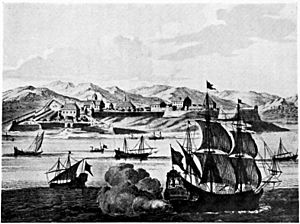Nombre de Dios, Colón facts for kids
Quick facts for kids
Nombre de Dios
|
|
|---|---|
|
Corregimiento and city
|
|

Illustration of an imagined Nombre de Dios, from Peter Schenk's 1672 Hecatompolis
|
|
| Country | |
| Province | Colón |
| District | Santa Isabel |
| Area | |
| • Land | 143.5 km2 (55.4 sq mi) |
| Population
(2010)
|
|
| • Total | 1,130 |
| • Density | 7.9/km2 (20/sq mi) |
| Population density calculated based on land area. | |
| Time zone | UTC−5 (EST) |
Nombre de Dios means "Name of God" in Spanish. It is a city and a type of local government area called a corregimiento in Panama. You can find it on the Atlantic coast of the Colón Province, within the Santa Isabel District.
This city was started by the Spanish in 1510. It was one of the very first European settlements on the Isthmus of Panama, which is the narrow strip of land connecting North and South America. In 2010, about 1,130 people lived there.
History of Nombre de Dios
Nombre de Dios is special because it is the oldest European settlement in the Americas that has been lived in continuously. For many years, it was a very important port. From about 1540 to 1580, it was the main place where ships loaded and unloaded goods in the Americas.
After a huge silver mine opened in Potosí (in present-day Bolivia) in 1546, silver was sent north to Panama City. From there, it was carried by mule trains (groups of mules carrying goods) across the narrow Isthmus of Panama to Nombre de Dios. Then, the silver was put on ships to go to Havana and Spain.
However, Nombre de Dios was built near an unhealthy swamp. It was also very hard to protect with forts. Because of these problems, its importance started to fade.
In June 1572, an English privateer named Francis Drake attacked the colony. A privateer was like a pirate, but they had permission from their government to attack enemy ships and towns. In April of the next year, Drake ambushed a Spanish Silver Train. This mule convoy was carrying a huge amount of precious metals.
Drake attacked the town again in 1595. But this time, he found very little treasure. He missed 5 million pesos that were waiting on the Pacific side of the Isthmus. After these attacks, the Spanish decided it was safer to use Portobelo as their main port on the Caribbean coast.
By 1580, Veracruz in Mexico became a more important port for Spain. Silver production in Mexico grew, while it dropped a lot in South America after 1700. By 1600, the Spanish had almost completely left Nombre de Dios. The town still exists today, but it is much smaller than it was in the 1500s.
Culture and Mentions
Nombre de Dios has been mentioned in famous poems.
The poet Derek Walcott wrote about it in his poem The Prodigal:
Caravels slid over the horizon.
The flags of the sea-almonds wilted
sacker of Nombre de Dios.
and yard-smoke drifted, forked as Drake's beard,—The Prodigal (p. 46)
The bay of Nombre de Dios is also mentioned in a poem by Sir Henry Newbolt called "Drake's Drum." This poem is about a legend of Sir Francis Drake:
Drake he's in his hammock an' a thousand miles away,
(Capten, art tha sleepin' there below?)
Slung atween the round shot in Nombre Dios Bay,
An' dreamin' arl the time o' Plymouth Hoe.
Yarnder lumes the Island, yarnder lie the ships,
Wi' sailor lads a-dancing' heel-an'-toe,
An' the shore-lights flashin', an' the night-tide dashin',
He sees et arl so plainly as he saw et long ago.
See also
 In Spanish: Nombre de Dios (Colón) para niños
In Spanish: Nombre de Dios (Colón) para niños


